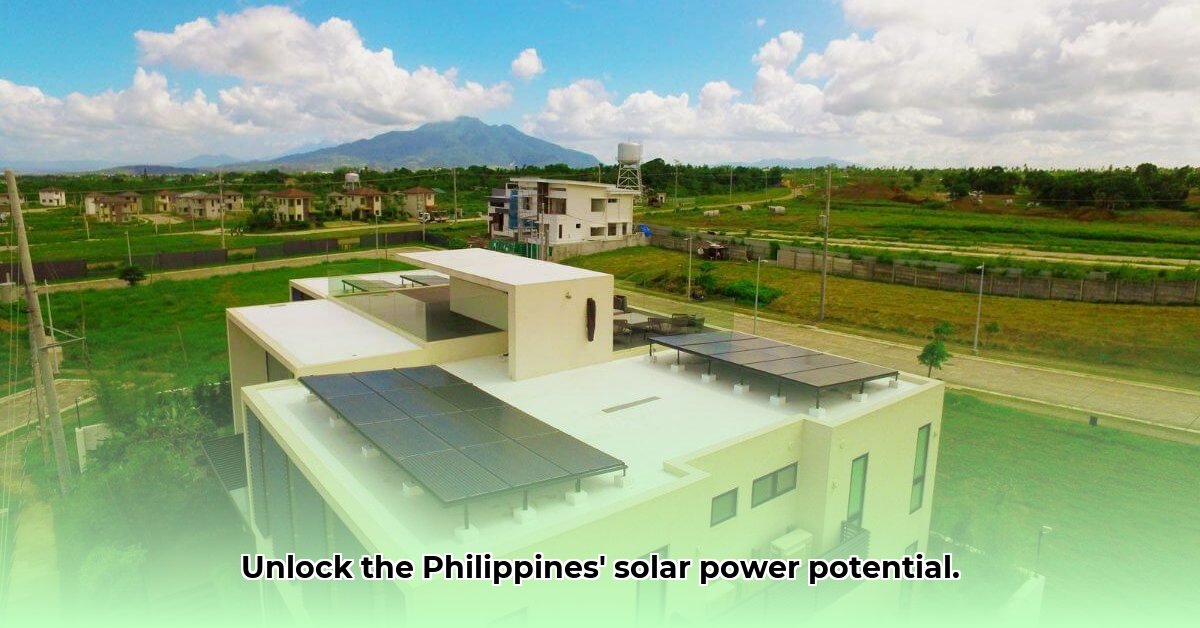The Philippines is blessed with abundant sunshine, presenting significant opportunities for solar energy development. This guide provides insights into navigating the Philippine solar landscape, from understanding costs and energy potential to installation processes and regulations, assisting in making informed decisions for residential or commercial solar projects. For more on solar ROI, see this helpful resource: Solar ROI data.
Solar Energy Investment in the Philippines: Investment Opportunities and Growth Potential
The Philippines is awash in sunshine, a vast, untapped resource awaiting utilization. The government is planning to vastly increase the use of solar power. While predicting the growth rate is challenging, the potential for investment returns is substantial. Studies suggest a payback period of around five years, making Philippine solar energy attractive. However, this can vary depending on system size and other variables like location, panel efficiency, and electricity consumption. Harnessing solar power can also reduce reliance on expensive diesel generators, potentially saving millions annually, particularly in island communities. Moreover, a stable regulatory environment, coupled with decreasing solar technology costs, is fostering a conducive environment for investment.
Growth Projections and Investment Returns
Predicting the exact trajectory of solar energy growth in the Philippines can be difficult. Factors like policy changes, technological advancements, and economic conditions can all influence the pace of development. However, despite these uncertainties, the potential for strong investment returns remains. Current studies suggest a payback period of approximately five years, making solar energy an attractive prospect for many investors. Remember that this timeframe can shift based on project-specific variables.
Philippine Solar Regulatory Landscape: Navigating Regulations and Incentives
The regulatory environment surrounding solar energy in the Philippines presents both opportunities and challenges. Streamlining regulations is like clearing road blocks, accelerating project timelines. This is especially important for smaller projects in remote areas requiring rural electrification. The government has implemented supportive policies and incentives to boost growth, but navigating the regulatory labyrinth can still be a daunting task. The Department of Energy (DOE), the Energy Regulatory Commission (ERC), and local government units (LGUs) all play key roles in shaping the regulatory landscape.
Key Regulatory Considerations for Solar Projects
Navigating regulations requires understanding Republic Act No. 9513 (Renewable Energy Act) and Republic Act No. 11285 (Energy Efficiency and Conservation Act). Compliance with local government units (LGUs) and securing permits, while adhering to building codes, can be time-consuming. Inconsistencies between national and local interpretations may introduce further complexities. Securing necessary certifications, adhering to net-metering guidelines, and staying abreast of evolving grid connection standards are also crucial. Furthermore, proposed changes to building codes that mandate solar-ready roofs could further streamline future installations.
Island Electrification: Solar Power and Energy Independence
Being an archipelago, energy distribution in the Philippines is complex due to lacking proper grid infrastructure. Clever solutions like microgrids and distributed generation systems become vital for energy independence, especially for isolated communities. These systems can dramatically reduce reliance on costly diesel generators, saving millions of dollars each year. The high cost of transporting fuel to remote islands makes solar power an economically attractive alternative, fostering self-sufficiency and resilience.
The Role of Microgrids in Distributed Generation
For communities on remote islands, clever solutions like microgrids and distributed generation systems are vital for achieving energy independence. Microgrids allow for localized energy generation and distribution, reducing transmission losses and improving grid stability. Integrating battery storage solutions with these microgrids further enhances reliability, ensuring a continuous power supply even when sunlight is not available.
Investment Strategies: Stakeholders and Opportunities
Investing in Philippine solar energy offers options for a variety of stakeholders, each with distinct strategies. Understanding these diverse approaches is crucial for maximizing returns and contributing to the country’s renewable energy goals.
| Stakeholder | Short-Term Strategies (0-1 Year) | Long-Term Strategies (3-5 Years) |
|---|---|---|
| Homeowners | Explore financing, assess roof suitability, compare solar installers, and perform energy audits to maximize system efficiency. | Fully transition to solar when practical, or consider community solar projects, and explore smart home energy management systems. |
| Businesses | Conduct feasibility analysis, explore Power Purchase Agreements (PPAs), determine any tax incentives, and assess opportunities for net metering. | Invest in substantial solar system expansions, enhance energy efficiency, consider battery storage integration, and implement corporate sustainability initiatives. |
| Government (DOE) | Simplify regulations, improve grid infrastructure, bolster incentives for rural electrification, and conduct public awareness campaigns. | Meet renewable energy goals, support technology advancement, build comprehensive rural electrification programs, and promote energy storage solutions. |
| International Investors | Assess investment risks, study regulations, identify promising rural projects, and establish partnerships with local entities. | Establish robust partnerships, facilitate technology transfer, fund large-scale initiatives, and advocate for policy reforms that support renewable energy development. |
| Solar Companies | Expand service offerings (PPAs, maintenance), improve customer education, streamline installation processes, and offer competitive financing options. | Innovate for rural electrification, implement cutting-edge technologies (floating solar, agrivoltaics), enhance grid connectivity, and develop sustainable business models. |
Actionable Steps for Key Stakeholders
- Homeowners: Explore financing options such as solar loans and leases to reduce upfront costs and assess roof suitability through professional inspections, ensuring structural integrity and optimal sunlight exposure.
- Businesses: Conduct feasibility studies to determine the viability of solar projects, explore Power Purchase Agreements to minimize initial financial outlay, and look into any potential tax breaks such as income tax holidays or accelerated depreciation.
- Government (DOE): Simplify permitting and licensing processes, improve the power grid which is crucial for distributing electricity, offer stronger incentives for bringing electricty to rural areas, and invest in energy education programs to raise public awareness.
- International Investors: Evaluate investment risks, study the regulations to navigate complex legal frameworks, find promising projects in rural areas for strong potential, and partner with experienced local firms to mitigate risks.
- Solar Companies: Broaden your services such as PPAs and maintenance to cater to more customer needs, educate customers better ensuring they understand the benefits of solar power, and offer end-to-end solutions from system design to installation and monitoring.
Brighter Future: Solar Energy’s Role in the Philippines
Solar energy is crucial for the Philippines’ energy security and long-term sustainability. Navigating regulations and embracing innovation are essential. Investors can unlock solar energy’s potential, contributing to a cleaner, more prosperous Philippines. This transition promises a more sustainable future powered by the sun and paves the way for economic growth, job creation, and improved quality of life.
Transforming Challenges into Opportunities
Despite these challenges, the potential benefits of solar energy are vast. By navigating regulations effectively and embracing new technologies and investments, stakeholders can unlock the immense power of solar energy in the Philippines. Innovative solutions like floating solar farms and agrivoltaic systems offer opportunities to maximize land use and promote food security.
Rural Electrification: Streamlining Solar Power Regulations
Key Takeaways:
- Solar plus storage: Cost-effective for rural electrification but there are still hurdles
- Crucial project success: Regulatory navigation
- Essential government support: Permit streamlining and subsidies
- Community engagement plus local capacity building: Are important.
- Clear & supportive private sector investment regulations
Philippines aims for 100% rural electrification by 2028. Solar power is essential in remote areas. Developers and Investors need a roadmap to navigate for project success and also understand laws (Republic Act No. 9513 (Renewable Energy Act) and Republic Act No. 11285 (Energy Efficiency and Conservation Act)). This involves permitting with local government, compliance and ensuring proper building codes. A streamlined regulatory framework is crucial for attracting investments and accelerating project deployment.
Understanding the Regulatory Framework and Key Players
Successful endeavors necessitate collaboration. The DOE is vital setting frameworks. Implementation relies on LGUs, electric cooperatives and the private sector. Clear communication and coordination between these entities are essential for project success.
- National Government: DOE should clarify subsidy standards for solar projects and streamline microgrids, providing clear guidelines and support mechanisms.
- Local Government Units (LGUs): Actively participate to project planning and ensure permit efficiency, expediting the approval process and reducing bureaucratic hurdles.
- Electric Cooperatives: Invest in training and billing improvements, enhancing their capacity to manage and integrate solar energy into their distribution networks.
- Private Sector: Engage with government and invest in underserved area projects, bringing innovation and expertise to the rural electrification effort.
A cooperative approach ensures project sustainability.
Challenges and Solutions: Addressing Barriers to Solar Adoption
Logistical challenges, and scarce skilled labor create substantial barriers. A proactive method,
- How Did Charles F. Brush Discover Wind Energy Tech? - November 19, 2025
- Wind Energy Vertical: Weighing the Pros and Cons of Wind Power - November 16, 2025
- How Much Energy Does a Wind Turbine Actually Create? - November 14, 2025
















